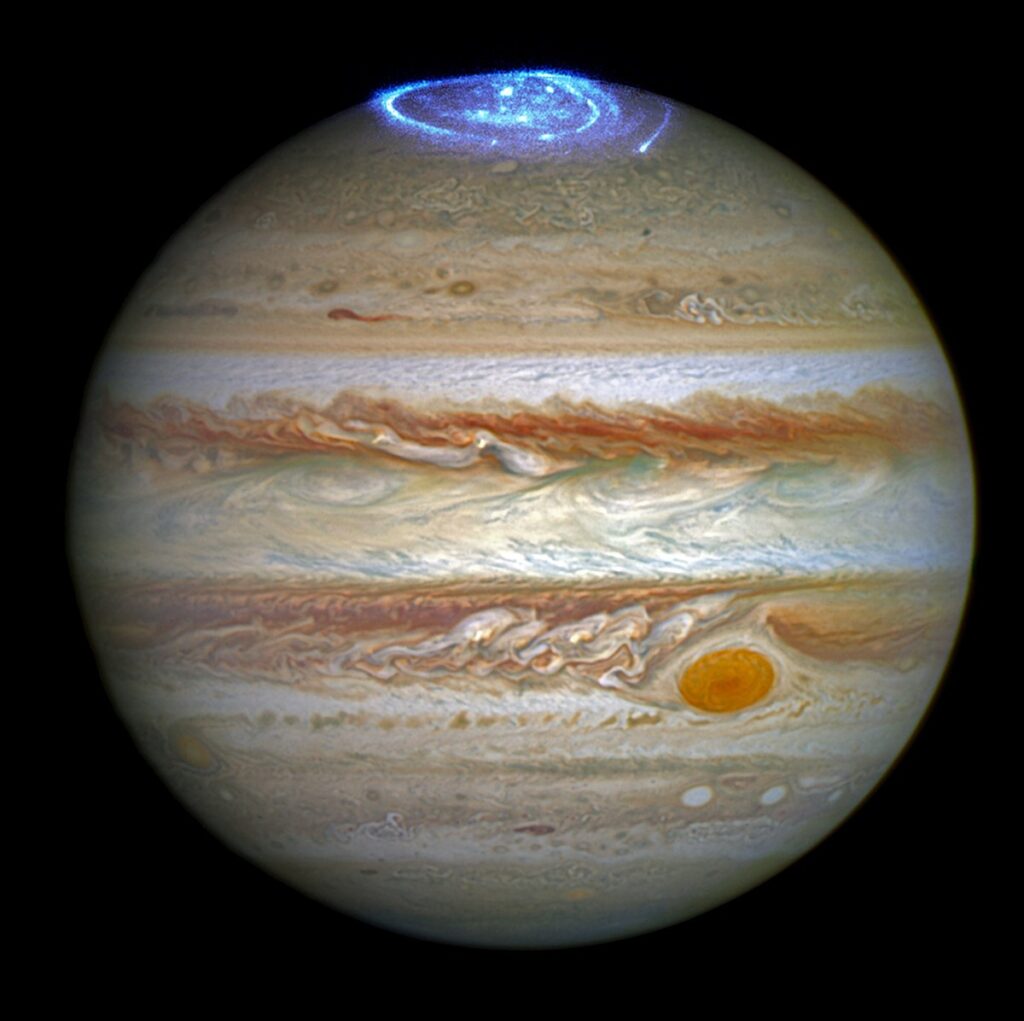First Water Vapor Found by Hubble on Jupiter’s Moon Ganymede
Astronomers have discovered proof of water vapor for the first time in the atmosphere of Jupiter’s moon Ganymede. When ice from the moon’s surface sublimates, or changes from a solid to a gas, water vapor is created.
The discovery, which was made using both fresh and historical Hubble Space Telescope data, was reported in the journal Nature Astronomy.

At ultraviolet and near-infrared wavelengths, Hubble can track changes on the moon and disclose additional properties. The presence of water vapor, which results from the thermal escape of water vapor from the moon’s frozen surface, has recently been demonstrated for the first time using new and archived Hubble datasets by astronomers.
Conclusive evidence from earlier studies suggests that Ganymede, the largest moon in the solar system, has more water in it than the oceans of Earth combined. But because it is so cold there, the water on the surface has frozen solid. The ocean beneath Ganymede would be around 100 miles deep, therefore the water vapor would not be an evaporation of this ocean.
To discover this proof of water vapor, astronomers reexamined Hubble images from the previous two decades.
The first ultraviolet (UV) photographs of Ganymede were captured by Hubble’s Space Telescope Imaging Spectrograph in 1998. These images showed colorful ribbons of electrified plasma known as auroral bands and added to the mounting evidence that Ganymede possesses a weak magnetic field.
The existence of molecular oxygen was used to explain the parallels in these UV data (O2). However, some of the observed patterns did not correspond to the expected emissions from an environment with only oxygen. At the same time, researchers came to the conclusion that this divergence was probably caused by increased levels of atomic oxygen (O).
Lorenz Roth of the KTH Royal Institute of Technology in Stockholm, Sweden led the team that set out to estimate the amount of atomic oxygen using Hubble as part of a significant observing effort to support NASA’s Juno mission in 2018. Hubble’s Cosmic Origins Spectrograph data from 2018 and old Space Telescope Imaging Spectrograph (STIS) photos from 1998 to 2010 were integrated in the team’s research.

To their amazement, and in contrast to the initial interpretations of the data from 1998, they learned that the atmosphere of Ganymede had very little atomic oxygen. This implies that the apparent disparities in these UV aurora photos require further justification.
The relative distribution of the aurora in the UV photos was subsequently examined in more detail by Roth and his team. The surface temperature of Ganymede changes significantly during the day, and around the equator around noon it may get warm enough to cause some little water molecule sublimation. In actuality, the apparent variations in the UV images are closely tied to the locations where water would be predicted to exist in the moon’s atmosphere.
These first ultraviolet (UV) photos of Ganymede were captured by Hubble’s Space Telescope Imaging Spectrograph (STIS) in 1998, and they showed a distinct pattern in the measured emissions from the moon’s atmosphere.
These first ultraviolet photos of Ganymede were captured by Hubble’s Space Telescope Imaging Spectrograph in 1998, and they showed a distinct pattern in the measured emissions from the moon’s atmosphere. Similar to aurora ovals seen on Earth and other planets with magnetic fields, the moon has auroral bands.

This served as demonstrative proof of Ganymede’s existence of a permanent magnetic field. The existence of molecular oxygen was used to explain the parallels in the ultraviolet data. At the time, the variations were attributed to the existence of atomic oxygen, which generates a signal that favors one UV color over the other.
Roth stated that just the molecular oxygen has been seen thus far. “This results from the ice surface being eroded by charged particles. The water vapor that we have recently measured results from the thermal escape of water vapor from warm icy places, which sublimates ice.”
This discovery heightens interest in the planned JUICE mission, which stands for Jupiter ICy moons Explorer, from the ESA (European Space Agency). Regarding JUICE, JUICE is the first large-class mission in the ESA’s Cosmic Vision 2015-2025 initiative. It will spend at least three years undertaking in-depth investigations of Jupiter and three of its largest moons, with a focus on Ganymede as a planetary body and potential habitat. The mission is scheduled to launch in 2022 and arrive at Jupiter in 2029.
Because of its unique magnetic and plasma interactions with Jupiter and its surroundings, Ganymede was chosen for in-depth study because it serves as a natural laboratory for studies of the nature, evolution, and possible habitability of icy worlds in general.

In order to maximize the usage of the spacecraft, Roth continued, “Our results can give the JUICE instrument teams useful information that may be used to improve their observation plans.”
Currently examining Ganymede closely, NASA’s Juno mission has just published new images of the icy moon. Since 2016, the Juno spacecraft has been observing Jupiter and the Jovian system.
Researchers have found signs of water vapor in the atmosphere of Jupiter’s moon Ganymede using fresh and historical Hubble Space Telescope information. The vapor is present because water molecules from the frozen surface of the moon were thermally excited. Previous studies have provided indirect evidence that the moon has more water than all of Earth’s oceans combined. The ocean, which is located around 100 miles below the crust, freezes over due to the extremely cold temperatures there.
We will gain a better understanding of the formation and evolution of gas giant planets and their satellites by studying the Jovian system and tracing its history from its inception through the potential appearance of habitable habitats. Additionally, presumably fresh information about the habitability of Jupiter-like exoplanetary systems will be discovered.
.




